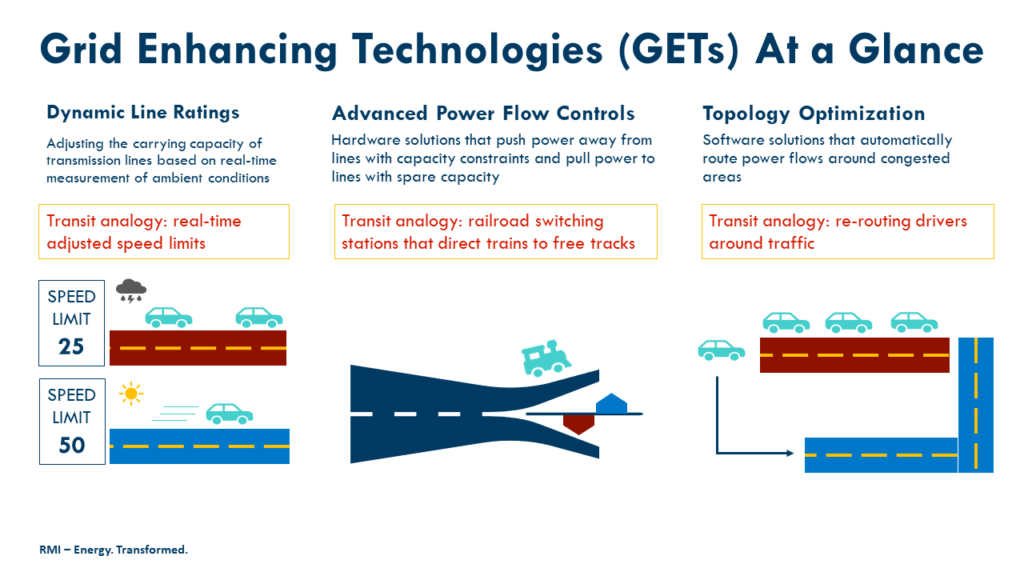
GET a GRIP: A Path to More Renewable Energy on the Grid
Grid-enhancing technologies could increase grid transmission capacity at a low cost. New DOE funds make that opportunity even more attractive.
If near-term transmission capacity expansion is on your holiday wish list, Christmas has officially come early. On November 14, the Department of Energy (DOE) opened applications for a second batch of grants for the Grid Resilience and Innovation Partnership (GRIP) program, less than one month after the first round of funding was awarded. The new round of funding opportunities — up to $3.9 billion — presents significant potential for projects like grid-enhancing technologies (GETs) and innovative partnerships to build and plan long-range transmission.
If that’s already enough acronyms for you, here’s why it matters: federal funding for these kinds of projects can free up needed electrical grid capacity, allowing for the affordable and timely integration of renewable energy projects. And capacity can’t come quick enough: 2 terawatts (TW) of generation and storage is waiting to connect to the grid in the United States, more than the total installed generation capacity currently operating.
The first round of funding announcements has already demonstrated that sizable impacts can come in small packages (more on that below). However, the funding that has been allocated so far is just the tip of the iceberg. To make substantial progress in creating the transmission capacity needed, utilities, regulators, and state governments need to take full advantage of federal funding opportunities like GRIP.
Why the grid is all stuffed up
This past year has illuminated the extent to which grid congestion is paralyzing capacity expansion in the United States. The main culprits are long and costly interconnection queues preventing generators from meeting new load demands, which are increasing faster than most projections. The median wait time to connect is now over five years, an untenable delay that has resulted in less than one-fifth of projects in the queue reaching completion. This problem largely stems from a lack of forward-looking transmission planning and the difficulty of building new long-range transmission projects, which can take decades to site, permit, and finance — if they get built at all.
Exhibit 1: A growing queue.
GETs can help bridge the gap
While there is no replacement for long-range regional and interregional transmission to meet future reliability needs, smaller grid efficiency projects can help us get more out of the existing grid in the near term. For instance, a study by consulting firm Brattle found that deploying GETs, such as dynamic line ratings (DLRs), advanced power flow controls, and topology optimization, could double renewable energy interconnection in Oklahoma and Kansas. Brattle estimated that scaling GETs nationally could save as much as $5 billion per year in electricity costs, lowering ratepayers’ bills. The study shows that the upfront costs for implementing the technology could be paid back in 6 months, as GETs are relatively inexpensive to install. (RMI also has a forthcoming analysis of GETs’ potential to expedite interconnection and reduce electricity costs for the PJM region, expected to be released in early 2024).
The first round of GRIP grants offered a small window into the impact federal funding can have on expanding grid capacity through GETs projects. Out of 34 total Smart Grid Grants, two were awarded to advanced power flow control projects and two supported DLR projects. One of the grants awarded to Algonquin Power Fund America to utilize advanced power flow controls is estimated to create 300 MW of additional grid capacity, enough to power approximately 100,000 homes with renewable energy. The next round of Smart Grid Grants will contain $1.08 billion, and the four GETs projects from the first round received an average of $28.5 million per project. If new proposed projects request approximately the same grant size, the new GRIP funding round could help implement as many as 35 GETs projects. The potential for this funding to scale capacity is immense: if each project resulted had roughly the same impact as the Algonquin grant, it would increase transmission capacity by more than 10 gigawatts (GW), enough electricity to power more than 3 million homes.
Funding in action
In addition to Smart Grid Grants there are two other buckets of funding within GRIP, the Grid Resilience Utility and Industry Grants which will have an additional $918 million and the Grid Innovation Program which will have another $1.82 billion to give out. The latter innovation grants can help with innovative partnerships to build more of the long-range transmission lines needed to integrate new wind and solar generation while maintaining grid reliability. One of the more exciting examples is a grant awarded to a partnership between the Confederated Tribes of Warm Springs (CTWS) and Portland General Electric (PGE) to build a 500 kV regional transmission line connecting Central Oregon with load centers in Willamette County. Central Oregon has significantly more renewable energy potential than coastal Oregon, where the majority of PGE’s customers live. The Warm Springs reservation alone has potential for 1.8 GW of renewable energy generation but is currently islanded and unable to deliver generation to load centers. This line would change that, providing an excellent template for collaboration between tribes and utilities on regional transmission.
One final example showcases GRIP funding for collaboration on interregional transmission planning through the Grid Innovation Grants. The grant funds the Joint Targeted Interconnection Queue (JTIQ) between states in the Midcontinent Independent System Operators (MISO) and the Southwest Power Pool (SPP) to coordinate the planning, design, and construction of five long-range interregional transmission projects. In DOE’s recently finalized Transmission Needs Study, the authors identified interregional transmission capacity as the single biggest need for the grid. The study specifically identified SPP and MISO as the most consequential regions for interconnecting, projecting that they could need as much as a 3000 percent increase in interregional transfer capacity between them to reliably meet electricity demand by 2040. The projected benefits from the success of the JTIQ are massive, with planners estimating it could unlock 30 GW of new generation in renewable resource rich states in the heart of the country.
Conclusion
There is an enormous range of projects offered by the GRIP program with grants ranging from just over a million dollars to nearly half a billion. The grants are matching and can support up to 50 percent of the total project costs, putting these essential tools to address grid congestion on sale for a limited time. DOE is accepting concept letters for the second round of GRIP grants only until January 12, 2024.
The available funding goes beyond GETs and transmission planning, and includes energy storage, HVDC terminal upgrades, and other grid services. These grants offer a rare opportunity for grid planners to cost-effectively address the elephant in the energy transition, grid congestion. By submitting and facilitating grant applications utilities and regulators can offer ratepayers the gift of affordable and reliable electricity, with reduced emissions.

